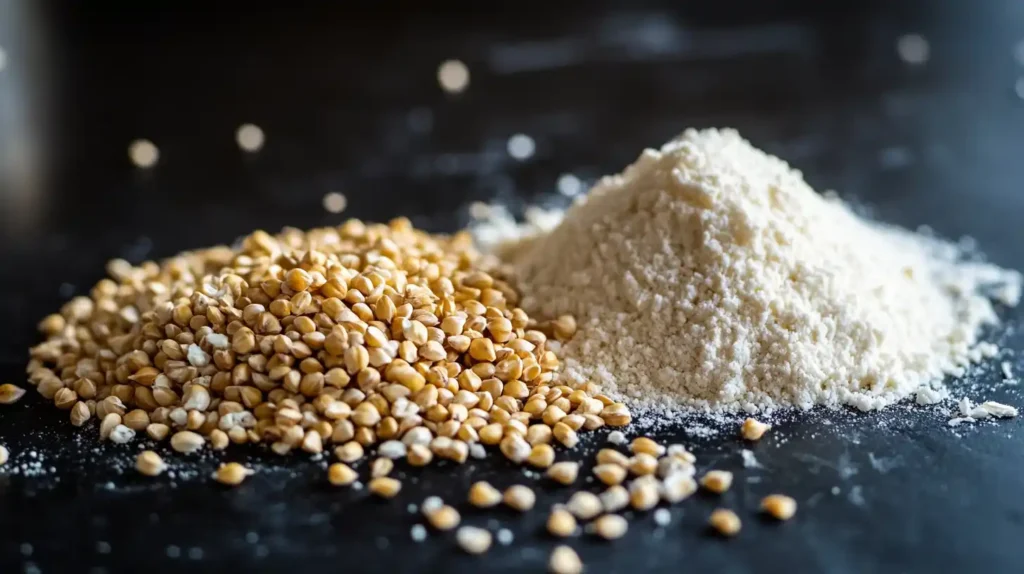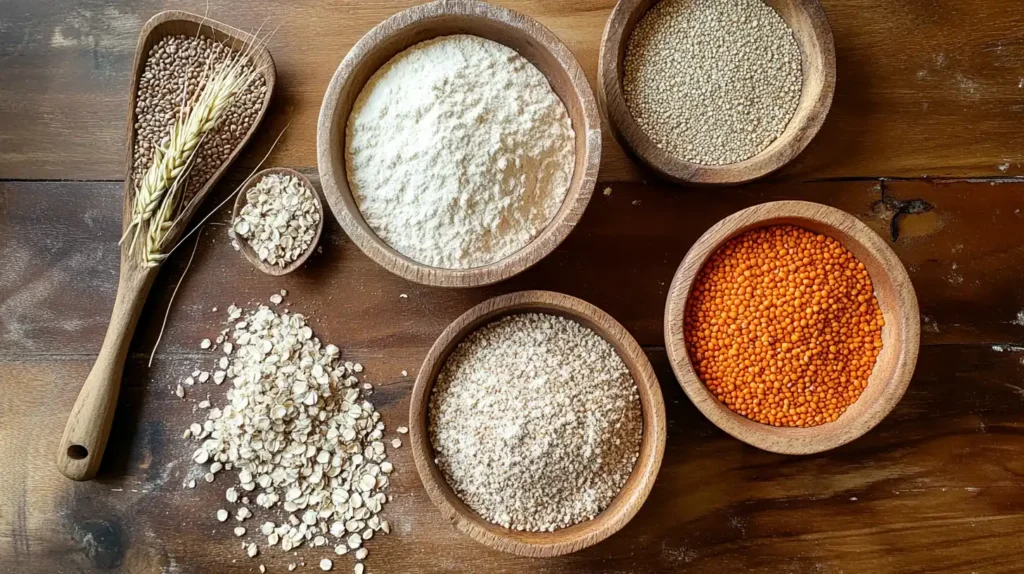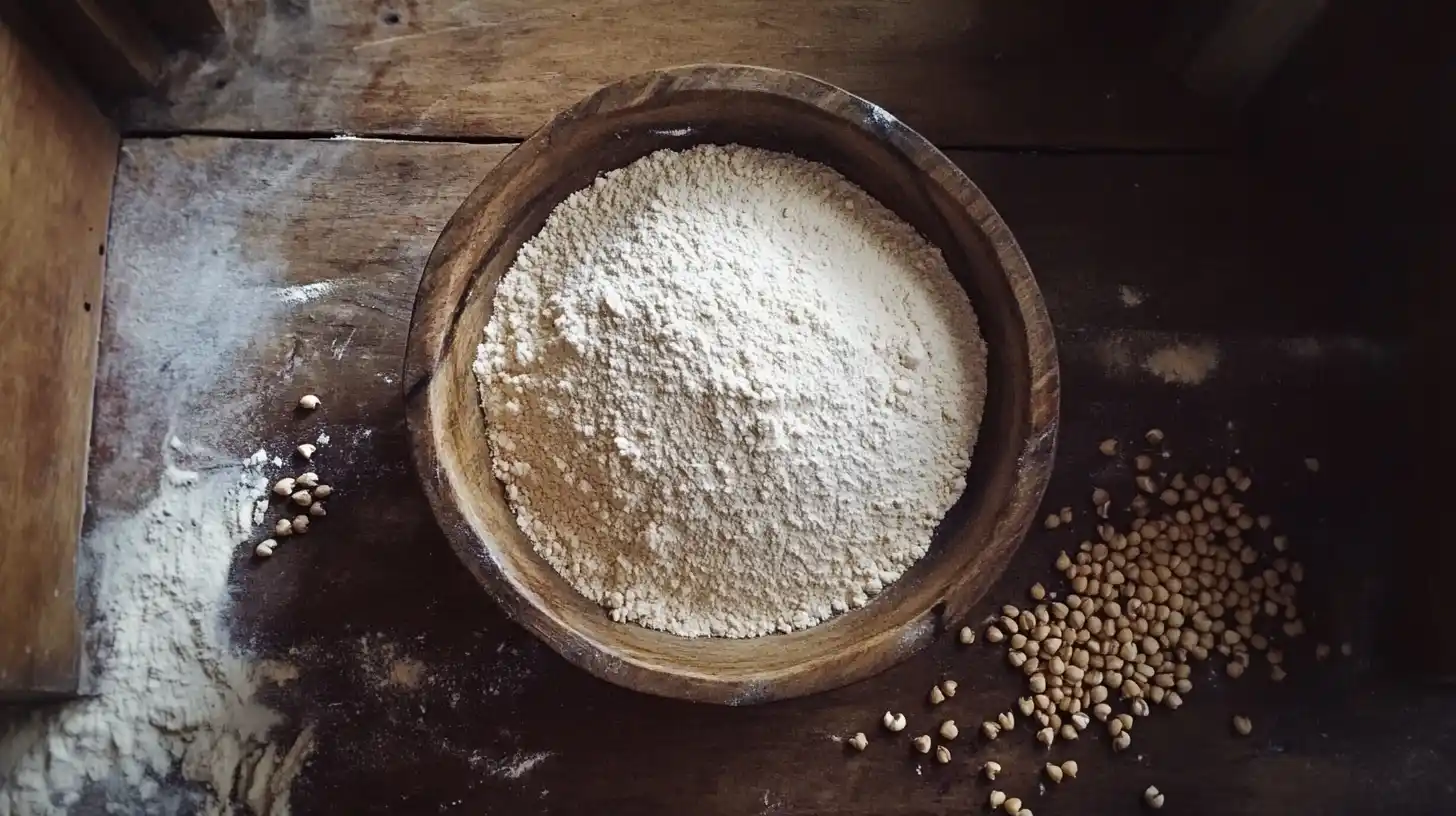What is buckwheat flour best for? This gluten-free flour alternative is packed with nutrients and works well in baking, cooking, and pasta-making. Whether you want to make pancakes, noodles, or bread, it adds a unique nutty flavor and offers numerous health benefits. Since it is naturally gluten-free, it is a great choice for people with gluten sensitivity or celiac disease.
Many people use it for baking, cooking, and even making pasta. It has a nutty flavor and a slightly earthy taste, making it an excellent ingredient in many recipes. Plus, it is full of fiber, protein, and important minerals.
But what is it best for? In this guide, we will explore:
- How it is made
- The different types of buckwheat flour
- Its health benefits
- The best ways to use it in cooking and baking
- How to substitute it for other flours
- Tips for buying and storing it
By the end, you will know exactly how to use it to make delicious and healthy meals.
What exactly is buckwheat flour?
Even though it is often grouped with grains, it is actually made from ground buckwheat groats, which come from the buckwheat plant. Unlike wheat, buckwheat is a seed, making it naturally gluten-free and an excellent choice for people with celiac disease or gluten intolerance.
Buckwheat has been used in many cultures for centuries. It is a key ingredient in French crêpes, Japanese soba noodles, and Russian blinis. Today, more people are turning to buckwheat flour because it is nutrient-dense, flavorful, and easy to use in many recipes.
How is Buckwheat Flour Made?
The process of making it is simple:
- Harvesting: Buckwheat plants are grown and harvested when the seeds, called groats, are fully matured.
- Cleaning: The groats are cleaned to remove any impurities.
- Grinding: The cleaned groats are finely ground into flour. The grinding process determines whether the flour is light or dark (we will explore the types later).
- Packaging: Once ground, the flour is packaged and stored in airtight bags to maintain freshness.

Because it is made from a whole food source, it retains more nutrients than refined wheat flour. This makes it a healthy alternative to traditional white flour.
Nutritional Profile of Buckwheat Flour
It is packed with essential nutrients, including:
- Protein – Helps build and repair tissues.
- Fiber – Supports digestion and keeps you feeling full longer.
- Magnesium – Helps regulate blood pressure.
- Iron – Important for energy production.
- Antioxidants – Protects the body from harmful free radicals.
Since it is gluten-free, it is a great choice for people following a gluten-free diet or looking for a healthier baking option.
Types of Buckwheat Flour
Not all buckwheat flour is the same. There are two main types, and each has its own unique characteristics. Choosing the right one depends on the recipe you are making.
1. Light
Light one is made from hulled buckwheat groats. This means the outer shell of the buckwheat seed is removed before grinding, resulting in a lighter color and milder flavor.
Best Uses for Light Buckwheat Flour:
- Delicate pastries – Adds a mild, slightly nutty taste.
- Cakes and muffins – Works well in gluten-free desserts.
- Pancakes and waffles – Gives a soft, fluffy texture.
Since light one has a finer texture, it is easier to work with when replacing all-purpose flour in many baking recipes.
2. Dark
Dark one is made from unhulled buckwheat groats, meaning the outer shell is left on before grinding. This gives the flour a richer color, stronger taste, and higher fiber content.
Best Uses for Dark Buckwheat Flour:
- Rustic bread and sourdough – Provides a hearty, earthy flavor.
- Pasta and noodles – Essential for making Japanese soba noodles.
- Savory pancakes and crepes – Adds a robust, nutty taste.
Since dark one contains more fiber and nutrients, it is often preferred for healthier, whole-grain recipes. However, it has a stronger taste, so if you’re new to it, you may want to start with light buckwheat flour first.
How to Choose the Right Type of Buckwheat Flour
- If you want a mild taste and soft texture, go for light one.
- If you prefer a stronger, nuttier flavor with more fiber, choose dark one.
- You can also mix both types to get the best of both worlds.
Health Benefits of Buckwheat Flour
It is not just a great alternative to wheat flour; it is also one of the healthiest gluten-free flours available. Packed with essential nutrients, it offers a range of health benefits that make it a great addition to your diet.
1. Naturally Gluten-Free
One of the biggest advantages of buckwheat flour is that it is 100% gluten-free. This makes it perfect for:
- People with celiac disease
- Individuals with gluten sensitivity
- Anyone following a gluten-free diet
Unlike many gluten-free flours, it does not require many additives to work in baking. You can use it in pancakes, cookies, and noodles without compromising texture or flavor.
2. High in Fiber for Better Digestion
It contains a good amount of dietary fiber, which helps:
- Support healthy digestion
- Prevent constipation
- Regulate blood sugar levels
Fiber is also essential for gut health, as it promotes the growth of good bacteria in the digestive system. This can improve overall well-being and even boost immunity.
3. Rich in Protein and Essential Amino Acids
Unlike many other flours, it is a complete protein, containing all nine essential amino acids. This makes it an excellent protein source for:
- Vegetarians and vegans.
- Athletes and those looking to build muscle.
For a high-protein breakfast option, try making protein blueberry pancakes using it.
Since protein helps keep you full, it can be useful for weight management as well.
4. Supports Heart Health
Several studies suggest that buckwheat flour can help improve heart health because it is:
- Rich in antioxidants that reduce inflammation
- A good source of magnesium, which supports healthy blood pressure
- Low in unhealthy fats, making it a heart-friendly option
It contains a special compound called rutin, which helps improve blood circulation and reduce the risk of heart disease.
5. Helps Regulate Blood Sugar Levels
Unlike refined white flour, it has a low glycemic index (GI), meaning it does not cause sharp spikes in blood sugar levels. This makes it a good choice for:
- People with diabetes
- Those managing their weight
- Anyone trying to avoid sugar crashes
Because of its high fiber and protein content, buckwheat flour slows down digestion and keeps energy levels stable throughout the day.
6. Packed with Vitamins and Minerals
Buckwheat flour is naturally high in:
- Magnesium – Supports heart health and muscle function.
- Iron – Helps prevent anemia and improves energy levels.
- Zinc – Boosts the immune system.
- B vitamins – Essential for energy and brain function.
Adding buckwheat flour to your diet can help you get more essential nutrients while enjoying tasty meals.

What is Buckwheat Flour Best For?
Buckwheat flour adds a nutty flavor and dense texture to baked goods, making it ideal for:
- Pancakes and waffles – Light and fluffy when paired with other flours.
- Cookies and biscuits – Adds a slightly crispy texture.
- Muffins and cakes – Works well in chocolate-based and spiced cakes.
1. Baking with Buckwheat Flour
One of the most popular ways to use buckwheat flour is in baking. It has a rich, nutty flavor that enhances both sweet and savory baked goods. It also adds a slightly denser texture, making it great for certain recipes.
Best Baking Uses for Buckwheat Flour:
- Pancakes and Waffles – it creates light and fluffy pancakes. People often use it to make traditional French buckwheat crêpes.
- Cookies and Biscuits – Adds a crisp texture to cookies and pairs well with chocolate, nuts, and dried fruits.
- Muffins and Cakes – Works well in chocolate-based or spiced cakes, adding depth to the flavors.
- Quick Breads – Great for making banana bread, zucchini bread, or buckwheat bread.
Because buckwheat flour is gluten-free, bakers often combine it with other flours, like almond flour or rice flour, to improve texture and elasticity.

2. Making Pasta and Noodles
People widely use it to make gluten-free pasta and noodles. One of the most famous examples is Japanese soba noodles, which primarily contain buckwheat and have a nutty, earthy flavor.
Why Use Buckwheat Flour for Pasta?
- Naturally gluten-free – A great alternative to wheat-based noodles.
- High in fiber and protein – Makes a more filling and nutritious meal.
- Firm texture – Holds up well when cooked, making it ideal for various dishes.
Best Uses for Buckwheat Flour in Pasta and Noodles
- Soba Noodles – Traditional Japanese noodles often served hot in broth or cold with dipping sauce.
- Homemade pasta: Use it to make rustic, hearty pasta with a unique texture.
- Gluten-Free Dumplings – Adds structure and flavor to dumpling dough.
Buckwheat pasta pairs well with light sauces, vegetables, and soy-based seasonings. If you want to try it, check out this guide to see how people use buckwheat in soba noodles.
3. Thickening Soups & Sauces
It is not just for baking and pasta; it is also a great natural thickener for soups, stews, and sauces. Because it has a fine texture, it blends easily into liquids, creating a smooth and creamy consistency.
Why Use Buckwheat Flour for Thickening?
- Gluten-Free Alternative – Perfect for people avoiding wheat-based thickeners like flour or roux.
- Adds a Mild Nutty Flavor – Enhances the taste of savory dishes.
- Thickens Without Lumps – Mixes well with warm liquids, making it easy to use.
Best Uses for Buckwheat Flour as a Thickener
- Soups and Stews – A small amount of buckwheat flour can add body and thickness to broths and chowders.
- Gravies and Sauces – Works well for making gluten-free gravy or creamy sauces.
- Vegetable Patties and Meatballs – Helps bind ingredients together, keeping them firm.
To use it as a thickener, simply whisk it into warm liquid until smooth. Let it simmer for a few minutes to reach the desired thickness.
How to Substitute Buckwheat Flour
Substituting buckwheat flour in recipes requires some adjustments because it lacks gluten. Here’s how you can do it effectively:
- For Baking: Replace up to 25-50% of the wheat flour with buckwheat flour.
- For 100% Gluten-Free Recipes: Combine it with other flours like almond, rice, or tapioca flour.
- For pancakes and waffles: You can use it as a one-to-one substitute for wheat flour.
By experimenting with these ratios, you can achieve the best texture and taste.
How to Store & Buy Buckwheat Flour
To keep buckwheat flour fresh:
- Store in an airtight container
- Keep in a cool, dry place
- Refrigerate for longer shelf life
When buying, look for organic, non-GMO options to get the best quality.
FAQs – People Also Ask
Many people have questions about it, especially when it comes to its uses, benefits, and substitutes. Below are some of the most common questions and answers to help you understand more about this versatile flour.
1. What Does Buckwheat Flour Taste Like?
It has a rich, nutty, and slightly earthy flavor. Dark buckwheat flour has a stronger, more robust taste, while light buckwheat flour is milder and more delicate. The flavor pairs well with both sweet and savory dishes.
2. Can Buckwheat Flour Replace All-Purpose Flour?
Yes, but with some adjustments. Since buckwheat flour does not contain gluten, it cannot directly replace all-purpose flour in recipes that require structure, such as bread or pizza dough. However, it works well in:
- Pancakes and waffles (can be used 1:1)
- Cookies and muffins (best when mixed with other gluten-free flours)
- Sauces and soups (as a natural thickener)
3. Is Buckwheat Flour Good for Weight Loss?
Yes, buckwheat flour can support weight loss because it is:
- High in fiber, keeping you full for longer.
- Rich in protein, which helps curb hunger.
- Lower in calories than many refined flours.
Including it in meals can help prevent overeating and sugar cravings.
4. How Do You Make it at Home?
Making homemade buckwheat flour is simple:
- Buy raw buckwheat groats (hulled or unhulled).
- Grind them in a high-speed blender, food processor, or grain mill.
- Sift the flour to remove any coarse bits.
- Store in an airtight container in a cool, dry place.
This method ensures freshness and lets you control the texture of the flour.
5. Does Buckwheat Flour Go Bad?
Yes, it can spoil if not stored properly. Since it contains natural oils, it has a shorter shelf life than refined flours. To keep it fresh:
- Store it in an airtight container.
- Keep it in a cool, dark place.
- For long-term storage, refrigerate or freeze it.
Proper storage helps prevent rancidity and spoilage.
6. Can You Make Bread with Buckwheat Flour?
Yes, but because it does not contain gluten, you need to mix it with other gluten-free flours or a binding agent like eggs, flaxseed, or xanthan gum. It is commonly used in:
- Gluten-free sourdough bread
- Buckwheat flatbreads
- Quick breads like banana or zucchini bread
7. Is Buckwheat Flour Keto-Friendly?
Not really. While it is gluten-free, it is still a carbohydrate-rich flour. It has a moderate glycemic index, making it unsuitable for a strict keto diet. However, it is a good choice for people following a low-glycemic or balanced-carb diet.
8. What Can I Use Instead of Buckwheat Flour?
If you need a buckwheat flour substitute, try these options:
- Almond flour – Low-carb and high in protein.
- Quinoa flour – A high-protein alternative.
- Brown rice flour – A mild-flavored gluten-free option.
- Oat flour – A naturally sweet, fiber-rich alternative.
These substitutes work well in different recipes depending on the texture and flavor needed.
9. Can You Eat Raw Buckwheat Flour?
Experts do not recommend eating raw buckwheat flour because it may be difficult to digest. Cooking or baking helps neutralize anti-nutrients and makes it easier to absorb its nutrients.
10. Why is Buckwheat Flour Popular in Gluten-Free Baking?
It is a favorite for gluten-free baking because:
- It has a rich, nutty taste.
- It provides a good structure when combined with other flours.
- It is high in fiber and nutrients, making baked goods more filling and nutritious.
Because of these benefits, many gluten-free recipes use it for better texture and taste.
Final Thoughts
Buckwheat flour is an incredibly versatile, nutritious, and gluten-free alternative to traditional wheat flour. Whether you are looking to bake delicious pancakes, make homemade soba noodles, or thicken soups and sauces, this flour offers a unique nutty flavor and impressive health benefits.
Because it is high in fiber, protein, and essential minerals, buckwheat flour is a great choice for people following a gluten-free, vegetarian, or heart-healthy diet. It helps regulate blood sugar levels, supports digestion, and keeps you full longer, making it an excellent ingredient for healthy cooking.
If you are new to buckwheat flour, start by using it in pancakes, muffins, or cookies. You can also experiment by mixing it with other gluten-free flours to find the best texture for your recipes. Since it absorbs moisture differently, you may need to make small adjustments when substituting it in baking.
To keep it fresh for longer, store buckwheat flour in an airtight container in a cool, dry place. If you do not plan to use it frequently, refrigerate or freeze it to extend its shelf life.
Now that you know what buckwheat flour is best for, why not try it in your next recipe? Whether you are making a warm stack of pancakes, hearty bread, or a flavorful noodle dish, buckwheat flour is a wonderful ingredient to explore.

